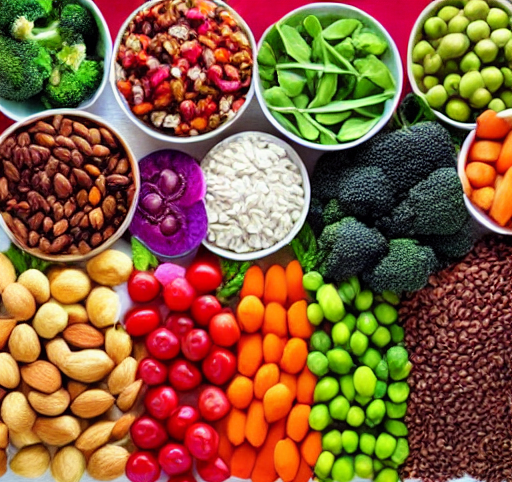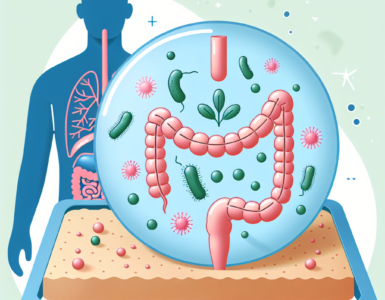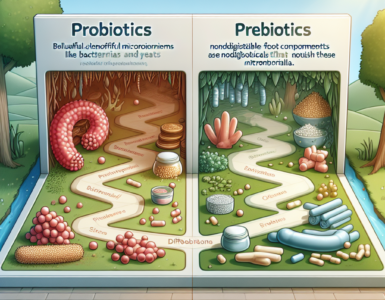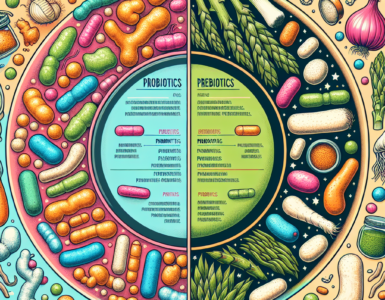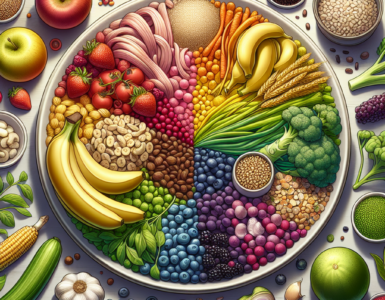Every day, more and more people are realizing the importance of maintaining a healthy diet to achieve overall wellness. One component of a balanced diet that often gets overlooked is fiber. This essential nutrient has a plethora of benefits that are vital for our body’s daily functions. In this article, we will delve into the world of fiber, its various sources, and the remarkable advantages it offers. We will also explore how to incorporate this essential nutrient into your daily meal plan, ensuring that you reap the rewards of a fiber-rich diet.
What is Fiber and Why is it Important?
Fiber is a type of carbohydrate that cannot be broken down by our bodies. It is found naturally in plant-based foods such as fruits, vegetables, legumes, and whole grains. Fiber is crucial for maintaining proper digestive health, keeping our heart healthy, and helping us maintain a healthy weight. There are two types of fiber: soluble and insoluble. Soluble fiber dissolves in water and forms a gel-like substance, which aids in lowering blood cholesterol and glucose levels. Insoluble fiber, on the other hand, does not dissolve in water, and it helps with digestion by adding bulk to the stool and preventing constipation.
The Remarkable Benefits of Fiber
- Promotes Digestive Health
One of the primary benefits of fiber is its role in promoting digestive health. It aids in the prevention of constipation by softening and increasing the bulk of the stool, making it easier to pass through the digestive tract. A diet rich in fiber can also help alleviate symptoms of irritable bowel syndrome (IBS) and reduce the risk of developing hemorrhoids. Moreover, fiber promotes the growth of beneficial gut bacteria, which contribute to a healthy gut microbiome and improved digestion.
- Supports Weight Management
Fiber-rich foods tend to be more filling than their low-fiber counterparts, meaning that you are likely to eat less and stay satisfied for longer periods. This can help you manage your weight more effectively. Additionally, fiber aids in maintaining stable blood sugar levels, reducing the likelihood of experiencing energy crashes and cravings for sugary snacks. By incorporating fiber into your daily diet, you can create a sustainable and effective weight management plan.
- Lowers Cholesterol Levels
Soluble fiber has been shown to lower cholesterol levels, specifically low-density lipoprotein (LDL) or “bad” cholesterol. It does so by binding with cholesterol particles in the digestive system and removing them from the body. High-fiber foods, such as oatmeal, beans, and certain fruits, are especially effective in reducing cholesterol levels.
- Helps Regulate Blood Sugar Levels
Fiber, particularly soluble fiber, can help regulate blood sugar levels by slowing down the absorption of sugar into the bloodstream. This can be particularly beneficial for individuals with diabetes, as it aids in managing blood sugar levels and reducing the risk of complications. Consuming fiber-rich foods can also reduce the risk of developing type 2 diabetes.
- May Reduce the Risk of Certain Cancers
A diet high in fiber has been linked to a reduced risk of certain types of cancer, including colorectal cancer. This is because fiber helps to move waste more quickly through the digestive tract, reducing the time that harmful substances stay in contact with the colon’s lining. While more research is needed to confirm these findings, it’s clear that fiber plays an essential role in maintaining a healthy digestive system.
Incorporating Fiber into Your Diet
Now that you understand the numerous benefits of fiber, you may be wondering how to incorporate it into your daily meal plan. Thankfully, doing so is relatively simple, as there are plenty of delicious and nutritious fiber-rich foods to choose from
Every day, more and more people are realizing the importance of maintaining a healthy diet to achieve overall wellness. One component of a balanced diet that often gets overlooked is fiber. This essential nutrient has a plethora of benefits that are vital for our body’s daily functions. In this article, we will delve into the world of fiber, its various sources, and the remarkable advantages it offers. We will also explore how to incorporate this essential nutrient into your daily meal plan, ensuring that you reap the rewards of a fiber-rich diet.
What is Fiber and Why is it Important?
Fiber is a type of carbohydrate that cannot be broken down by our bodies. It is found naturally in plant-based foods such as fruits, vegetables, legumes, and whole grains. Fiber is crucial for maintaining proper digestive health, keeping our heart healthy, and helping us maintain a healthy weight. There are two types of fiber: soluble and insoluble. Soluble fiber dissolves in water and forms a gel-like substance, which aids in lowering blood cholesterol and glucose levels. Insoluble fiber, on the other hand, does not dissolve in water, and it helps with digestion by adding bulk to the stool and preventing constipation.
The Remarkable Benefits of Fiber
- Promotes Digestive Health
One of the primary benefits of fiber is its role in promoting digestive health. It aids in the prevention of constipation by softening and increasing the bulk of the stool, making it easier to pass through the digestive tract. A diet rich in fiber can also help alleviate symptoms of irritable bowel syndrome (IBS) and reduce the risk of developing hemorrhoids. Moreover, fiber promotes the growth of beneficial gut bacteria, which contribute to a healthy gut microbiome and improved digestion.
- Supports Weight Management
Fiber-rich foods tend to be more filling than their low-fiber counterparts, meaning that you are likely to eat less and stay satisfied for longer periods. This can help you manage your weight more effectively. Additionally, fiber aids in maintaining stable blood sugar levels, reducing the likelihood of experiencing energy crashes and cravings for sugary snacks. By incorporating fiber into your daily diet, you can create a sustainable and effective weight management plan.
- Lowers Cholesterol Levels
Soluble fiber has been shown to lower cholesterol levels, specifically low-density lipoprotein (LDL) or “bad” cholesterol. It does so by binding with cholesterol particles in the digestive system and removing them from the body. High-fiber foods, such as oatmeal, beans, and certain fruits, are especially effective in reducing cholesterol levels.
- Helps Regulate Blood Sugar Levels
Fiber, particularly soluble fiber, can help regulate blood sugar levels by slowing down the absorption of sugar into the bloodstream. This can be particularly beneficial for individuals with diabetes, as it aids in managing blood sugar levels and reducing the risk of complications. Consuming fiber-rich foods can also reduce the risk of developing type 2 diabetes.
- May Reduce the Risk of Certain Cancers
A diet high in fiber has been linked to a reduced risk of certain types of cancer, including colorectal cancer. This is because fiber helps to move waste more quickly through the digestive tract, reducing the time that harmful substances stay in contact with the colon’s lining. While more research is needed to confirm these findings, it’s clear that fiber plays an essential role in maintaining a healthy digestive system.
Incorporating Fiber into Your Diet
Now that you understand the numerous benefits of fiber, you may be wondering how to incorporate it into your daily meal plan. Thankfully, doing so is relatively simple, as there are plenty of delicious and nutritious fiber-rich foods to choose from
Every day, more and more people are realizing the importance of maintaining a healthy diet to achieve overall wellness. One component of a balanced diet that often gets overlooked is fiber. This essential nutrient has a plethora of benefits that are vital for our body’s daily functions. In this article, we will delve into the world of fiber, its various sources, and the remarkable advantages it offers. We will also explore how to incorporate this essential nutrient into your daily meal plan, ensuring that you reap the rewards of a fiber-rich diet.
What is Fiber and Why is it Important?
Fiber is a type of carbohydrate that cannot be broken down by our bodies. It is found naturally in plant-based foods such as fruits, vegetables, legumes, and whole grains. Fiber is crucial for maintaining proper digestive health, keeping our heart healthy, and helping us maintain a healthy weight. There are two types of fiber: soluble and insoluble. Soluble fiber dissolves in water and forms a gel-like substance, which aids in lowering blood cholesterol and glucose levels. Insoluble fiber, on the other hand, does not dissolve in water, and it helps with digestion by adding bulk to the stool and preventing constipation.
The Remarkable Benefits of Fiber
- Promotes Digestive Health
One of the primary benefits of fiber is its role in promoting digestive health. It aids in the prevention of constipation by softening and increasing the bulk of the stool, making it easier to pass through the digestive tract. A diet rich in fiber can also help alleviate symptoms of irritable bowel syndrome (IBS) and reduce the risk of developing hemorrhoids. Moreover, fiber promotes the growth of beneficial gut bacteria, which contribute to a healthy gut microbiome and improved digestion.
- Supports Weight Management
Fiber-rich foods tend to be more filling than their low-fiber counterparts, meaning that you are likely to eat less and stay satisfied for longer periods. This can help you manage your weight more effectively. Additionally, fiber aids in maintaining stable blood sugar levels, reducing the likelihood of experiencing energy crashes and cravings for sugary snacks. By incorporating fiber into your daily diet, you can create a sustainable and effective weight management plan.
- Lowers Cholesterol Levels
Soluble fiber has been shown to lower cholesterol levels, specifically low-density lipoprotein (LDL) or “bad” cholesterol. It does so by binding with cholesterol particles in the digestive system and removing them from the body. High-fiber foods, such as oatmeal, beans, and certain fruits, are especially effective in reducing cholesterol levels.
- Helps Regulate Blood Sugar Levels
Fiber, particularly soluble fiber, can help regulate blood sugar levels by slowing down the absorption of sugar into the bloodstream. This can be particularly beneficial for individuals with diabetes, as it aids in managing blood sugar levels and reducing the risk of complications. Consuming fiber-rich foods can also reduce the risk of developing type 2 diabetes.
- May Reduce the Risk of Certain Cancers
A diet high in fiber has been linked to a reduced risk of certain types of cancer, including colorectal cancer. This is because fiber helps to move waste more quickly through the digestive tract, reducing the time that harmful substances stay in contact with the colon’s lining. While more research is needed to confirm these findings, it’s clear that fiber plays an essential role in maintaining a healthy digestive system.
Incorporating Fiber into Your Diet
Now that you understand the numerous benefits of fiber, you may be wondering how to incorporate it into your daily meal plan. Thankfully, doing so is relatively simple, as there are plenty of delicious and nutritious fiber-rich foods to choose from.
Here are some suggestions on how to increase your fiber intake:
- Start Your Day with a Fiber-Rich Breakfast
Opt for whole-grain cereals, oatmeal, or whole-grain toast to kick-start your day with a good dose of fiber. You can also add fruits like berries or a sliced banana to your cereal or yogurt for an extra boost.
- Make Whole Grains a Staple in Your Meals
Switch from refined grains, such as white rice and white bread, to whole grains, including brown rice, quinoa, barley, and whole-grain pasta. These whole grains not only provide more fiber but also contain more vitamins, minerals, and phytonutrients.
- Incorporate More Fruits and Vegetables
Aim to consume at least five servings of fruits and vegetables every day. Choose a variety of colors and types to ensure you’re getting a wide range of nutrients. Remember that the skin of many fruits and vegetables contains a significant amount of fiber, so try to eat them with their skin on when possible.
- Snack on Nuts and Seeds
Nuts and seeds are not only excellent sources of healthy fats but also rich in fiber. Keep a stash of almonds, walnuts, chia seeds, or sunflower seeds in your pantry for a quick and nutritious snack. However, be mindful of portion sizes, as nuts and seeds are calorie-dense.
- Include Legumes in Your Diet
Beans, lentils, and peas are all excellent sources of both soluble and insoluble fiber. Try adding them to soups, stews, salads, or even as a side dish. They are not only versatile but also packed with essential nutrients like protein, iron, and potassium.
- Stay Hydrated
As you increase your fiber intake, it’s essential to drink plenty of water. This is because fiber absorbs water in the digestive tract, softening the stool and making it easier to pass. Staying hydrated also ensures that your body can effectively process the increased fiber intake.
- Gradually Increase Your Fiber Intake
To avoid digestive discomfort, it’s crucial to increase your fiber intake gradually. Rapidly increasing fiber in your diet can lead to bloating, gas, or diarrhea. Allow your body to adjust by gradually adding more fiber-rich foods over a few weeks.
The Different Types of Fiber-Rich Foods
Understanding the various types of fiber-rich foods can help you make more informed choices about your diet. Here are some categories of fiber-rich foods, along with examples from each group:
- Whole Grains
- Brown rice
- Quinoa
- Barley
- Oats
- Whole-grain bread and pasta
- Fruits
- Apples
- Pears
- Berries
- Bananas
- Oranges
- Vegetables
- Leafy greens (spinach, kale, collard greens)
- Broccoli
- Cauliflower
- Carrots
- Sweet potatoes
- Legumes
- Beans (black, kidney, pinto, etc.)
- Lentils
- Chickpeas
- Peas
- Nuts and Seeds
- Almonds
- Walnuts
- Chia seeds
- Flaxseeds
- Sunflower seeds
Fiber Supplements: What You Need to Know
If you find it challenging to meet your daily fiber needs through food alone, you may consider adding a fiber supplement to your routine. Fiber supplements come in various forms, such as powders, capsules, and gummies. However, it’s essential to keep in mind that getting fiber from whole foods is always preferable, as they provide additional nutrients and health benefits.
Before starting any supplement, consult with your healthcare provider to ensure it’s appropriate for you. Also, remember that fiber supplements should be taken with plenty of water to avoid digestive discomfort.
Cooking with Fiber: Delicious and Nutritious Recipes
Incorporating fiber into your meals doesn’t have to be a chore. With a little creativity, you can create delicious and nutritious dishes that are packed with fiber. Here are a few recipe ideas to get you started:
- Overnight Oats
Combine rolled oats, chia seeds, and your choice of milk in a jar. Add a touch of sweetness with honey or maple syrup, then let it sit in the refrigerator overnight. In the morning, top it with fresh fruit and nuts for a fiber-rich breakfast.
- Vegetable Stir-Fry
Sauté a variety of colorful vegetables, such as bell peppers, broccoli, and snap peas, in a little bit of oil. Add your choice of protein, like tofu or chicken, and a flavorful sauce. Serve over brown rice or quinoa for a fiber-packed meal.
- Lentil Soup
Cook lentils with onion, carrot, and celery in a flavorful broth. Add your favorite herbs and spices for extra depth of flavor. This hearty soup is a great way to enjoy a fiber-rich meal while warming up on a chilly day.
- Chickpea Salad
Toss cooked chickpeas with chopped cucumber, tomato, red onion, and fresh parsley. Drizzle with a lemon-tahini dressing for a refreshing and fiber-filled salad that’s perfect for lunch.
The Importance of Balance: Fiber in the Context of a Well-Rounded Diet
While fiber is a critical component of a healthy diet, it’s essential to remember that it’s just one part of the puzzle. A well-rounded diet should also include an appropriate balance of protein, healthy fats, vitamins, and minerals. Be sure to consume a variety of nutrient-dense foods to support your overall health and well-being.
In conclusion, incorporating fiber into your daily diet can lead to numerous health benefits, such as improved digestion, weight management, heart health, and even reduced cancer risk. By understanding the different types of fiber-rich foods and how to cook with
them, you can effortlessly add more fiber to your meals. Don’t forget to consider the importance of balance in your diet and consume a variety of nutrient-dense foods to support your overall health and well-being. With a little creativity and planning, you can unlock the secrets of a fiber-rich diet and enjoy its numerous benefits.
Fiber and Exercise: A Winning Combination
In addition to a fiber-rich diet, regular exercise is essential for maintaining optimal health. Combining a high-fiber diet with an active lifestyle can enhance the benefits of both. Regular exercise helps improve digestion, which can further aid in preventing constipation and other digestive issues. Additionally, exercise can help in weight management and reducing the risk of chronic diseases like heart disease and type 2 diabetes. Aim to incorporate at least 150 minutes of moderate-intensity aerobic activity or 75 minutes of vigorous-intensity aerobic activity per week, along with muscle-strengthening activities on two or more days per week.
Fiber for Kids: Establishing Healthy Habits Early
Fiber and Aging: The Role of Fiber in Healthy Aging
Children can also benefit from a fiber-rich diet. Fiber plays a crucial role in maintaining healthy digestion and preventing constipation in kids. Moreover, establishing healthy eating habits early in life can set the foundation for long-term health and well-being. Encourage your children to consume a variety of fiber-rich foods, such as whole grains, fruits, and vegetables. Make mealtime fun and engaging by involving your kids in meal planning and preparation. This not only teaches them about the importance of a healthy diet but also helps them develop essential life skills.
As we age, our bodies undergo various changes, and our nutritional needs may also shift. A fiber-rich diet can play a crucial role in healthy aging by promoting digestive health, weight management, and heart health. Seniors should aim to consume at least 21-30 grams of fiber per day for women and 30-38 grams per day for men, depending on their age. To achieve this, focus on incorporating a variety of fiber-rich foods into your diet, such as whole grains, fruits, vegetables, legumes, nuts, and seeds. Additionally, staying hydrated and engaging in regular physical activity can further support overall health and well-being as we age.
The Bottom Line
Fiber is an essential component of a healthy diet, providing numerous benefits that contribute to overall wellness. By understanding the various sources of fiber and incorporating them into your daily meals, you can enjoy improved digestion, weight management, heart health, and much more. Remember to maintain a well-rounded diet and engage in regular exercise to support your health in the long term. Embrace the power of fiber and unlock the secrets of a healthy diet for yourself and your family today.
Conclusion
The benefits of fiber are undeniable, and incorporating it into your daily diet can lead to improved digestion, weight management, heart health, and overall well-being. By making simple changes to your meal plan and gradually increasing your fiber intake, you can reap the rewards of this essential nutrient. Remember to stay hydrated, and don’t be afraid to get creative in the kitchen, as there are countless delicious and nutritious fiber-rich recipes to try. Embrace the power of fiber and unlock the secrets of a healthy diet today.
Disclaimer
Any changes to your routine should not be made using the content of this article. Always take care of your health and seek advice from healthcare professionals.
Note: The information provided in this article is for educational purposes only and is not intended to be a substitute for professional medical advice, diagnosis, or treatment. Always seek the advice of your physician or other qualified healthcare provider with any questions you may have regarding a medical condition.


